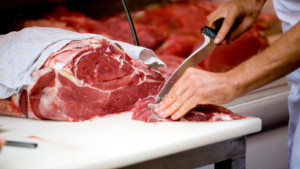As part of a quantitative microbiological risk assessment (QMRA) food chain model, this article describes a model for the consumer phase for Salmonella-contaminated pork products.
 Three pork products were chosen as a proxy for the entire pork product spectrum: pork cuts, minced meat patties, and fermented sausages. For pork cuts cross-contamination is considered the most important process and therefore it is modeled in detail. For minced meat, both cross-contamination and undercooking are the relevant processes. For those commodities bacterial growth during transport and storage is also modeled. Fermented sausages are eaten raw and the production may be defective.
Three pork products were chosen as a proxy for the entire pork product spectrum: pork cuts, minced meat patties, and fermented sausages. For pork cuts cross-contamination is considered the most important process and therefore it is modeled in detail. For minced meat, both cross-contamination and undercooking are the relevant processes. For those commodities bacterial growth during transport and storage is also modeled. Fermented sausages are eaten raw and the production may be defective.
Variability between consumers’ behavior and the impact of variability between production processes at the farm and abattoir are taken into account. Results indicate that Salmonella levels on products may increase significantly during transport and storage. Heating is very efficient at lowering concentrations, yet cross-contamination plays an important role in products that remain contaminated. For fermented sausage it is found that drying is important for Salmonella reduction.
Sensitivity analysis revealed that cross- contamination factors “knife cleaning” and “preparation of a salad” are important parameters for pork cuts. For minced meat cleaning of the board, salad consumption, refrigerator temperature, and storage time were significant.
A QMRA model for Salmonella in pork products during preparation and consumption
Risk Analysis
N. Swart, F. van Leusden and M. J. Nauta
http://onlinelibrary.wiley.com/doi/10.1111/risa.12522/abstract
